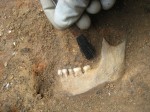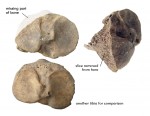 Burned and cut bone fragments from the Boudiccan revolt have been discovered at the redevelopment site of supermarket Williams & Griffin in Colchester, southeast England. The two pieces, one of mandible and the other of tibia, were found mixed in with burned building debris that had been moved to the location and used as fill during the reconstruction of Colchester after Boudica’s army burned the city to the ground in 61 A.D. Although the revolt-era layer of the town has been extensively excavated, these are only the second human remains ever found in Colchester’s Boudiccan debris, and the first were unearthed 50 years ago in 1965.
Burned and cut bone fragments from the Boudiccan revolt have been discovered at the redevelopment site of supermarket Williams & Griffin in Colchester, southeast England. The two pieces, one of mandible and the other of tibia, were found mixed in with burned building debris that had been moved to the location and used as fill during the reconstruction of Colchester after Boudica’s army burned the city to the ground in 61 A.D. Although the revolt-era layer of the town has been extensively excavated, these are only the second human remains ever found in Colchester’s Boudiccan debris, and the first were unearthed 50 years ago in 1965.
The reason so few bones have been found in a city that was completely destroyed is that the inhabitants were rounded up and killed in the sacred groves of the Iceni war goddess Andraste. Cassio Dio goes into gruesome detail on the subject in Book 62, Chapter 7 of his Roman History:
The worst and most bestial atrocity committed by their captors was the following. They hung up naked the noblest and most distinguished women and then cut off their breasts and sewed them to their mouths, in order to make the victims appear to be eating them; afterwards they impaled the women on sharp skewers run lengthwise through the entire body. All this they did to the accompaniment of sacrifices, banquets, and wanton behaviour, not only in all their other sacred places, but particularly in the grove of Andate.
Colchester, the Roman colony of Camulodunum, was the first target of Boudica’s forces. It had great symbolic significance to them. The city had been the capital of the Trinovantes, the Iceni’s allies in the uprising, and it was there that they had had to surrender to Claudius in 43 A.D. The next year a temple to Claudius was built to commemorate the great victory/humiliating defeat and the legions used the city as a fortress for another five years. When they left, retired Roman veterans moved in, displacing the native Britons, taking their land and enslaving them. The veterans didn’t bother to build fortifications, however, so Boudica’s army made short shrift of the city. Surviving veterans fled to Claudius’ temple where Boudica besieged them for two days before it too fell and was torched along with the rest of Camulodunum.
 When the bone pieces were first unearthed last week, the evidence of burning was clearly visible in situ, but it wasn’t until archaeologists removed the fragments for additional study that the found evidence that the bones had been cut with a sharp instrument of some kind, possibly a weapon.
When the bone pieces were first unearthed last week, the evidence of burning was clearly visible in situ, but it wasn’t until archaeologists removed the fragments for additional study that the found evidence that the bones had been cut with a sharp instrument of some kind, possibly a weapon.
The cut mark on the shinbone is the most convincing. The bone is a left tibia where the top front left-hand side has been sliced off with a sharp blade. The blow must have been ferocious and it must have cut through part of the end of the thigh bone (femur) and probably the kneecap (patella) and the fibula (the thin bone alongside the tibia). The angle of the cut suggests that the leg must have been flexed and that the person who cut it wasn’t standing directly in front of him but to his right or left.
The mandible is more difficult to interpret. Now that it is out of the ground, we can see that it does indeed have its third molar and that the person was much older when he died than we thought. What is striking, however, is that the inside edge of the raised part at the back of the jaw is missing. It looks as if this part of the jaw has been sliced off where the bone is quite thin. But the cut looks rather delicate for a sword blow. It may be that the jawbone simply cracked in the ground and this part became detached. But then, in the light of the chop mark on the leg bone, some kind of deliberate incision, violent or delicate, needs to be considered as a possiblity [sic]. If the damage was the result of a sword blow, then it must have been a downwards one from the man’s left. The sword must have crashed clean through his left cheek bone (the zygomatic bone) between his left eye and ear so that it just nicked the front of the upper part of his jaw.
The cut marks on the bones look very clean to be shovel marks, but it is possible that the mandible in particular was damaged during the reconstruction by a shovel, say, rather than by a blade.
These bones and those unearthed in 1965 were found 100 yards from each other. Archaeologists have just begun to dig at a third site that lies between the two find spots, so there may be more interesting news from the Boudiccan revolt to report soon.